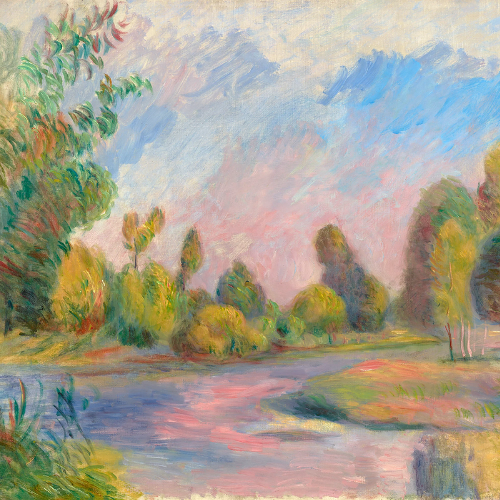“If I see further than others, it is because I stand on the shoulders of giants.” - Sir Isaac Newton
Dive into the vibrant seascape of Willy Schlobach's Les falaises, where the echoes of Monet's Impressionist brilliance and Seurat's Pointillist innovation come alive. As the best students do, Schlobach harmonizes the legacies of masters, creating a unique and necessary dialogue in art history.
A Vista to Remember: Belle-Île

Les Rochers de Belle-Ile, la Côte sauvage by Claude Monet. 1886. Musée d’Orsay.
Belle-Île, an island off the coast of Brittany in France, holds significant importance in the context of Impressionism, a revolutionary art movement that emerged in the late 19th century. This scenic island became a source of inspiration for numerous Impressionist painters, including Monet, Gauguin, Matisse, Moret and more. These artists were insatiably drawn to its rugged coastline, dramatic cliffs and the interplay of light and color in its landscapes. Belle-Île, with its dynamic natural scenery, provided the perfect subject for artists to explore these new techniques of light, expressive brushstrokes and symbolism.
Claude Monet and the rocky seascape

|
|
The island's significance in Impressionism is particularly tied to Claude Monet, one of the movement's pioneers. In 1886, Monet spent several months on Belle-Île, producing dozens of paintings that captured the rugged beauty of the landscape. In many ways, it was this landscape that taught him to embrace his bold use of color and expressive brushstrokes, characteristics that would come to define Impressionism.
This painting, Près de Fécamp, marine (Seascape Near Fécamp) embodies the genius Belle-Île led him to embrace. In this incredible vista, one can see Monet's mastery in depicting light and atmosphere through a palette of purples, oranges, greens, and blues, embodying his Impressionist ideals.
Monet’s early 1880 seascapes, including Près de Fécamp, marine, achieved immediate success and were largely acquired by Monet's dealer, Paul Durand-Ruel. These works are celebrated for their unique atmospheric qualities and are considered among Monet's finest. His seascapes from this period are featured in prestigious museums worldwide, including the Musée d’Orsay, the Metropolitan Museum of Art, and the Art Institute of Chicago, highlighting Monet's enduring impact on Impressionist art.
Post-Impressionist Evolution

Le mouillage à Grandcamp by Georges Seurat. Circa 1885. M.S. Rau.
While Georges Seurat, a French Post-Impressionist artist, certainly knew about Monet and the greater Impressionist movement, he took a different approach to the alluring seaside landscape. This painting, Le mouillage à Grandcamp was completed during the summer of 1885 in a quaint fishing village in Normandy. It represents a key phase in Seurat's exploration of light, color, perception and optics. It was through such marine paintings that Seurat refined his Pointillism technique, a then-controversial approach involving the scientific application of complementary colors to evoke harmony and emotion. Today, this method is celebrated as one of the most groundbreaking in art history.
In Le mouillage à Grandcamp, Seurat employs a mosaic of blue, green and yellow brushstrokes to depict the sea, with the distant buildings merging into the horizon. He often allowed the warm brown of the panels to serve as a background color, adding depth and unity to the composition. The painting is notable for its vibrant use of light, particularly in rendering the overcast sky and the luminous sea.
This work marked a turning point in Seurat's artistic style. His Normandy coast scenes from this period, including Le mouillage à Grandcamp, are highly coveted and are part of collections in prestigious museums worldwide.
A Beautiful Blend: Willy Schlobach

Schlobach, born in 1864, studied at the Académie des Beaux-Arts in Brussels and in Ghent, swiftly establishing himself as a notable figure in Belgian art. Influenced by Théo van Rysselberghe and the Neo-Impressionist techniques of Seurat and Signac, he became known as the "Belgian Divisionist." Schlobach's work, particularly his coastal scenes, reflects a meticulous pointillist approach, making him a distinguished artist of his time. His works are featured in prominent museum collections globally.
Interested in more Impressionist and Post Impressionist works? Check out our collections and blogs!







